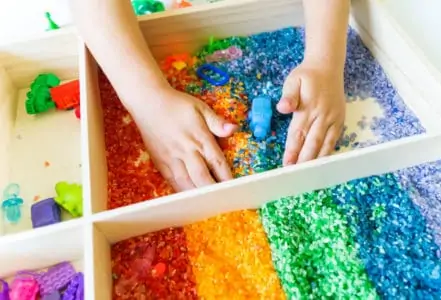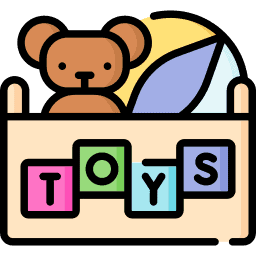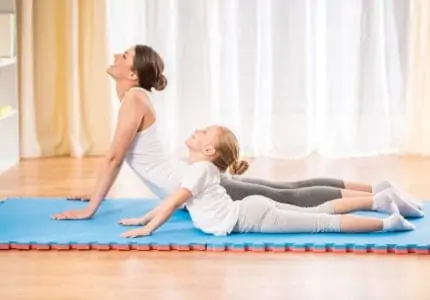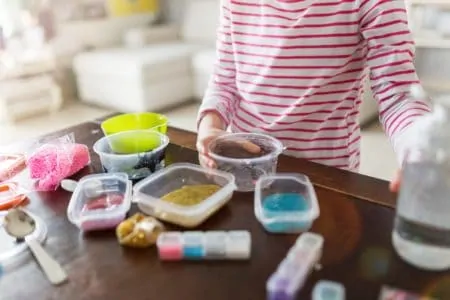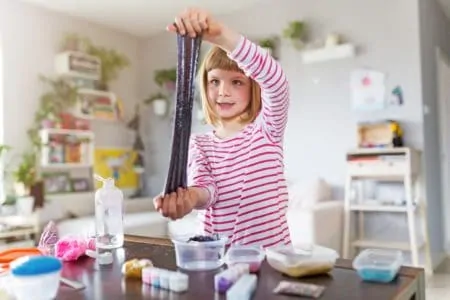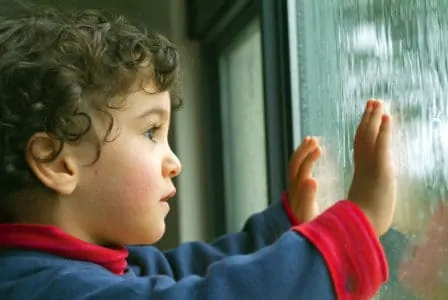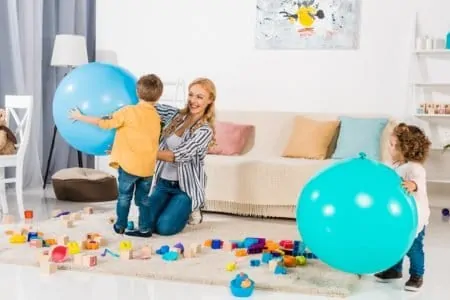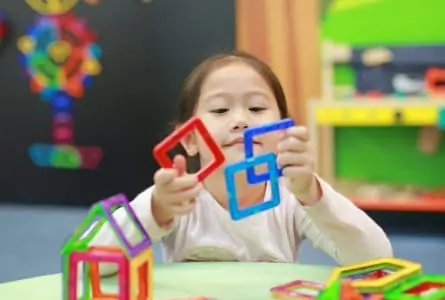Plus, it’s a fantastic way to keep them entertained.
Here is a breakdown of why sensory activities matter, answers to common questions, and 30 fun ideas you can set up at home.
Key Takeaways
- Brain boost: Sensory play builds nerve connections that support complex learning and language development.
- Skill building: These activities enhance fine motor skills, problem-solving, and social interaction.
- Emotional regulation: Sensory inputs can help calm anxious children and teach self-regulation.
- Easy setup: Most activities use household items like ice, flour, food coloring, and soap.
Benefits of Sensory Activities for Kids
Why is sensory play so important? Here are the biggest benefits for your little one.
- It expands vocabulary: When you describe hot, cold, squishy, or rough textures while playing, you teach your child descriptive words. This gives them the tools to express their thoughts and feelings later.
- It builds brain connections: Stimulating the senses teaches the brain to recognize and respond to different signals. This strengthens neural pathways needed for more complex tasks down the road.
- It boosts problem-solving skills: Sensory games are often experiments in cause and effect. Your child learns that squeezing creates a shape or mixing colors creates a new one.
- It aids self-regulation: Many sensory activities, like calm-down bottles or lavender dough, help children slow down. It teaches them to listen to their bodies and manage big emotions.
- It reduces anxiety: Focused, repetitive play can be meditative. Activities with calming scents or smooth textures can help soothe an anxious child.
- It teaches social skills: Sensory bins are great for parallel play. Kids learn to share tools, take turns, and communicate non-verbally with peers.
We asked caregivers for their favorite sensory activities for kids. These are the top 30, broken down by age group.
Sensory Activities for Toddlers
Toddlers explore with their mouths, so safety is key. These activities are designed for curious little ones who might try to taste their toys.
Ice Ice Baby
It doesn’t get simpler than this. Put ice cubes or crushed ice into a heavy-duty Ziploc bag and seal it tightly with duct tape.
Place it on a highchair tray or floor. Your child can squeeze the cold bag, push the ice around, and watch it melt without getting wet or cold fingers.
To The Moon Sand And Back
Grab a plastic bin and fill it halfway with flour. Pour in baby oil (or edible vegetable oil if your toddler tastes everything) and mix.
The flour and oil create a moldable, sand-like texture. It holds its shape when squeezed but crumbles easily. If it’s too sticky, add flour. If it won’t clump, add oil.
Edible “Water Beads”
Traditional water beads are a major choking hazard, but tapioca pearls are a safe alternative. Boil large tapioca pearls for 5, 7 minutes until soft but chewy.
Drain and cool them in ice water. Dye them with food coloring in a baggie for vibrant colors. Toss them in a bin with water, spoons, and cups for a “soup” station. They are fully edible, slimy, and fun.
Fruit Dip
Fill a bin with dry rice or water. Slice up lemons, limes, and oranges. Drop the fruit slices into the bin.
The citrus scent stimulates the sense of smell, while the textures vary between the rind and the fruit. Since it’s just fruit, it’s safe if they take a lick, though the sour taste might surprise them!
Peek-A-Boo Sensory Board
Save your baby wipe lids. Glue them onto a piece of cardboard or wood.
Inside each opening, glue a different texture: a scrap of carpet, sandpaper, crinkly foil, or soft felt. Your toddler can flip the lids open to discover the surprise texture underneath.
Blooming Senses
Enhance store-bought or homemade playdough with essential oils or cocoa powder for scent.
Give your child a ball of dough and some large sunflower seeds. Show them a picture of a flower and help them poke the seeds into the dough to create patterns. It’s excellent for pincer grasp practice.
Edible Ocean
This one is messy but tasty. Make blue Jello and let it set. Cut it into cubes and dump them into a clean bin.
Add gummy fish or clean plastic sea animals. Let your child squish the “water” and rescue the fish. It’s a full tactile and taste experience.
Frog Pond
Water play teaches buoyancy and physics. Fill a tub with water. Cut lily pads out of green craft foam, they stick to the sides of the tub when wet!
Add plastic frogs and let your toddler make them jump from pad to pad. Add blue food coloring for extra depth.
Fizzy Shapes
This classic science experiment doubles as sensory play. Place cookie cutters or plastic containers on a tray.
Put a spoonful of baking soda inside each one, hiding a drop of food coloring underneath. Give your toddler a squeeze bottle of vinegar. When they squirt the vinegar, the shapes erupt in fizzy colors.
Don’t Eat This Pasta
Cook spaghetti until al dente. Toss it with a little oil to prevent total sticking, then let it cool.
Put it in a bowl and let your child squish it. It feels like slimy worms. You can dye the pasta different colors while boiling it for a rainbow effect.
Sensory Activities for Preschoolers
Preschoolers are ready for slightly more complex play and engaging their imaginations.
Sensory Bubble Foam
Shaving cream can sting eyes, so make this tear-free foam instead.
Mix 1/4 cup of tear-free bubble bath (or body wash) with 1/2 cup of water. Use a hand mixer to whip it up until stiff peaks form. It creates a thick, luxurious foam that holds its shape. Add food coloring for a “unicorn” foam effect.
Under The Sea
Dye water blue and add it to a bin. Toss in sand on one side to create a beach.
Add smooth stones, seashells, and plastic marine animals. Kids can explore the difference between wet and dry sand and wash the shells in the ocean.
Oatmeal Sensory Bin
Dry oats make a great, taste-safe alternative to sand. Fill a bin with rolled oats.
Throw in scoops, measuring cups, and funnels. Hide small toys or pom-poms in the oats and have your child dig them out with tongs to practice fine motor skills.
We All Scream For Ice-Cream
Make cloud dough (flour and oil) or purchase generic playdough. Add vanilla extract or strawberry scent.
Provide ice cream scoops, silicone cupcake liners, and sprinkles. Your child can run their own ice cream shop, scooping and decorating “treats.”
Paintsicles
Fill an ice cube tray with washable tempera paint. Stick a craft stick into each slot and freeze.
Once solid, pop them out and let your child paint on cardstock. The melting ice creates a cool watercolor effect, and the sensation of cold paint adds a new tactile element.
Grassy(ish)
If you don’t have a lawn, grow a mini one. Sprinkle cress seeds on damp paper towels or cotton balls in a tray.
In just a few days, you’ll have a sprout jungle. Let kids drive toy tractors through it or use scissors to give the grass a “haircut.”
Herb & Spice Play Dough
Divide a batch of homemade playdough into four parts. Knead a different spice into each: cinnamon, ginger, rosemary, and mint.
Ask your child to close their eyes and guess the smell. Discuss how certain smells remind us of holidays or foods.
When Life Gives You Lemons
Fill a bin with warm water and halved lemons. Add lemon juicers, ladles, and cups.
Encourage your child to squeeze the juice out. It strengthens hand muscles. Add a dash of dish soap for lemon-scented bubbles.
Bug Fossils
Press playdough flat into a container. Push plastic bugs or dinosaurs deep into the dough to create impressions.
Let the dough dry slightly or just cover it with “dirt” (cocoa powder or crushed cereal). Have your child excavate the bugs and match them to their footprints.
Bunny Bait
Fill a bin with water and add gentle scrub brushes. Toss in real carrots with the greens attached, radishes, or celery.
Let your child scrub the veggies clean. It teaches practical life skills and exposes them to vegetable textures without the pressure to eat them (though they might take a bite!).
Sensory Activities for Kids
Older kids still benefit from sensory input, especially for stress relief and focus.
Frozen
Freeze a large block of ice with small toys trapped inside. Give your child a spray bottle of warm water and salt.
They have to melt the ice to rescue the toys. It teaches states of matter and patience.
Lavender Slime
Slime is the ultimate sensory tool. Make a basic batch using clear glue and activator.
Add a drop of purple food coloring and a few drops of lavender essential oil. The stretching action combined with the scent makes this a powerful anti-anxiety tool.
Flower Threading
Cut a cardboard shape (like a heart or ring) and wrap it with yarn. Go on a nature walk to collect dandelions, daisies, and leaves.
Have your child weave the stems through the yarn. It requires focus and fine motor precision, resulting in beautiful, ephemeral art.
Thermo-Dynamic Sludge (Oobleck)
Mix cornstarch and water (roughly 2 parts cornstarch to 1 part water). This creates a non-Newtonian fluid.
It acts like a solid when you punch it but flows like a liquid when you hold it gently. It is messy but fascinating for older kids to explore.
Lavender Cupcakes
Baking is a sensory activity that ends with a treat. Use a simple vanilla recipe and add culinary-grade lavender.
Let kids measure, mix, and smell ingredients. Frosting the cupcakes works on hand-eye coordination.
Buggy Hand Soap
Encourage hygiene by making custom soap. Use a clear liquid hand soap bottle.
Have your child insert small plastic bugs or beads into the bottle. As they use the soap, the bugs move around. It makes hand-washing much more interesting.
Floating Hearts?
Fill a tall glass halfway with water, then top with baby oil or vegetable oil.
Freeze colored water into ice cubes (heart shapes are cute, but any work). Drop the ice into the glass. The ice will float between the oil and water layers, melting slowly and sending colored droplets down. It’s a mesmerizing density experiment.
Slo-Mo Sensory Bottle
Fill a bottle with 1 part clear hair gel and 6 parts warm water. Shake to mix.
Add fine glitter and Lego bricks or beads. The gel thickens the water, causing the items to fall in slow motion. It is perfect for a “calm down corner.”
Pumpkin Scoop
Cut the top off a pumpkin. Let your kid use their hands to pull out the seeds and slimy guts. It’s a unique texture some kids love (and some hate!).
Once empty, you can do a vinegar and baking soda volcano inside the pumpkin shell.
Sensory Path
Create a walking path using shallow bins. Fill one with bubble wrap, one with soft towels, one with dry beans, and one with fake grass.
Have your child walk barefoot across them. This stimulates the soles of the feet and challenges their balance.
FAQs About Sensory Activities
Here are answers to the most common questions about sensory play.
A Feast For The Senses
You don’t need expensive toys to help your child develop. A bowl of ice, a bin of rice, or a batch of homemade dough offers a world of learning.
These activities encourage children to notice the details of their environment, the smells, sounds, and textures that make up their world. So grab a bin, pick an activity, and get ready to play!
